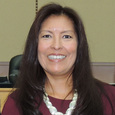Native American lawyers in the United States feel overlooked both as a minority group and in their individual careers, and their paltry numbers won’t grow without focused efforts to recruit and retain them in the profession, a survey has found.
“Often times, Native American attorneys are simply invisible,” said Mary Smith, immediate past president of the National Native American Bar Association, which commissioned the first comprehensive survey of Native American lawyers.
She attributes that to both the small number of Native American lawyers — 2,600, according to the bar association’s estimates — and even smaller proportional representation. Native Americans, who include American Indians, Alaska natives and native Hawaiians, together comprise 1.6 percent of the U.S. population, but less than half a percent of all lawyers.


By contrast, African-Americans comprise 4.2 percent of lawyers; while Hispanics and Asian-Americans each account for 5.1 percent, according to the U.S. Bureau of Labor Statistics. Many lawyer diversity studies fail to include Native Americans, said Lawrence Baca, a former association president who spent 32 years in the U.S. Department of Justice before retiring in 2008. Judge Diane Humetewa (far left), a member of the Hopi tribe appointed to the U.S. District Court for the District of Arizona in 2014, is the only Native American serving on a federal district or circuit court. A single Native American runs a law school — Stacey Leeds (left), dean of the University of Arkansas School of Law, is a member of the Cherokee Nation. Fewer than 30 law professors belong to an indigenous nation, according to the report.
The association surveyed more than 500 practicing lawyers about their jobs, motivations for entering the profession and professional satisfaction. Respondents included lawyers working for tribes, the government, law firms and in-house. It released its findings in April.
Recruiting and retention strategies proven successful with other minority groups, including programs that steer high school and college students into the pipeline that leads to law schools, have left Native Americans behind, Smith said. “A cookie-cutter solution on diversity and inclusion doesn’t work,” she said.
Identifying Native Americans within the profession is one obstacle. People who aren’t enrolled members of registered tribes claim Native American ancestry, and some members don’t disclose that in the workplace. All of the survey respondents considered themselves Native American, yet 8 percent did not so identify at work.
Law schools don’t require applicants to provide proof of heritage, which can lead to “box checking” by people who hope for an affirmative action advantage, according to the report. Law schools believe they are enrolling more indigenous students than they actually are, Baca said. Leeds, the dean, agreed that Native American students are overcounted but opposes requiring applicants to supply a tribal membership registration number as proof, since other minority applicants face no such mandate.
Native American attorneys are more likely to pursue legal careers out of a desire to help their tribes than personal career ambition, the survey found.
Baca grew up in San Diego in the 1950s, when signs declaring “No Indians allowed” were common in the windows of suburban businesses. “Growing up, I made the decision to go to law school,” he said. “I wanted to work for the California Indian Legal Services. I fit the profile you see in the study dead center.”
Baca, a member of the Pawnee Nation of Oklahoma, graduated from Harvard Law School in 1976. He clerked for the Native American rights-focused nonprofit as a law student but upon graduation went to work in the Justice Department’s Civil Rights Division, taking on as many Indian discrimination cases as his supervisors would allow.
STING OF DISCRIMINATION
Still, Baca felt the sting of discrimination. He was told more than once that he “wrote like an Indian” — an assessment he never knew what to make of beyond realizing it was not a compliment. He didn’t work directly with another Native American until landing in the Office of Indian Rights in 2004, where he spent his final four years in the Justice Department.
“I fought like crazy to get [the Civil Rights Division] to accept that Indians are victims of civil rights discrimination,” Baca said of the 1970s and 1980s. “There was a mindset among the old guard that cut their teeth on cases where an African-American man was being discriminated against by a white man. Native Americans just didn’t register.”
Well more than half of Native American attorneys surveyed — 64 percent — practiced federal Indian law, which pertains to federally recognized tribes. Nearly 59 percent practiced tribal law — the legal systems deployed within sovereign tribes. More than 21 percent of respondents reported working directly for Native American tribes. Twelve percent worked at private firms of 50 or fewer attorneys. About 8 percent worked for the federal government.
Attorneys working within the tribal sector reported the highest level of career satisfaction and those in the federal government the lowest. Respondents described a lack of personal connections with colleagues. More than 40 percent said they had faced racially motivated demeaning comments or harassment on the job.
Attorneys in private practice said they felt left out of their firms’ career-development and social networks.
“Working as an attorney in federal Indian law in a major market, the projects are often driven by the desires of the clients with the most money — often the goals and priorities of these clients are not aligned with and or are damaging to tribal clients who need help the most,” one respondent said.
Native American law students feel marginalized from their first day on campus, said Leeds, who became dean in 2011. It’s not uncommon to be the only indigenous student in their class. First-year civil procedure class in most cases makes no mention of the tribal courts. “The issues or experiences you’ve had aren’t even on people’s radars,” she said.
Hunter Cox, president of the National Native American Law Students Association and a member of the Prairie Band Potawatomi Nation, can count on one hand the number of classmates at the University of Michigan Law School active in indigenous matters. He networks primarily with Native American students at other law schools, during gatherings such as the student bar’s annual moot court competition.
‘THE ONLY INDIAN’
“You feel like you’re the only Indian in school, kind of. But that’s been my whole life,” said Cox, a second-year student. “I always feel like I’m speaking on behalf of all Indian people.”
Native American law students cluster at schools with dedicated Indian law programs, such as Arizona State University Sandra Day O’Connor College of Law; the University of New Mexico School of Law; and the University of Tulsa College of Law, Leeds said. Students at other law schools may have little or no regular contact with Native American classmates and rarely consider that perspective in class discussions, she said.
Outreach must begin as early as middle school to set students on the law school path, the study concludes. The American Indian Law Center’s Pre-Law Summer Institute — a two-month program held each summer at the University of New Mexico School of Law — is an effective pipeline program. But it prepares incoming law students for the rigors of the next three years rather than recruit young Native Americans who haven’t contemplated a career in the law but could make good lawyers.
Programs that prepare minority law students for the Law School Admission Test must recruit more Native American participants, Leeds said. American Indians posted the second-lowest average LSAT score among all racial groups in 2012 — the most recent year studied by the Law School Admission Council.
These students may lack the financial resources to pay for pricey LSAT prep courses, Baca said. “If you can’t afford it, you’re probably going to score much lower than someone who can,” he said. “Diversity programs as a whole need to be more inclusive if we’re going to bring more American Indians in.”



